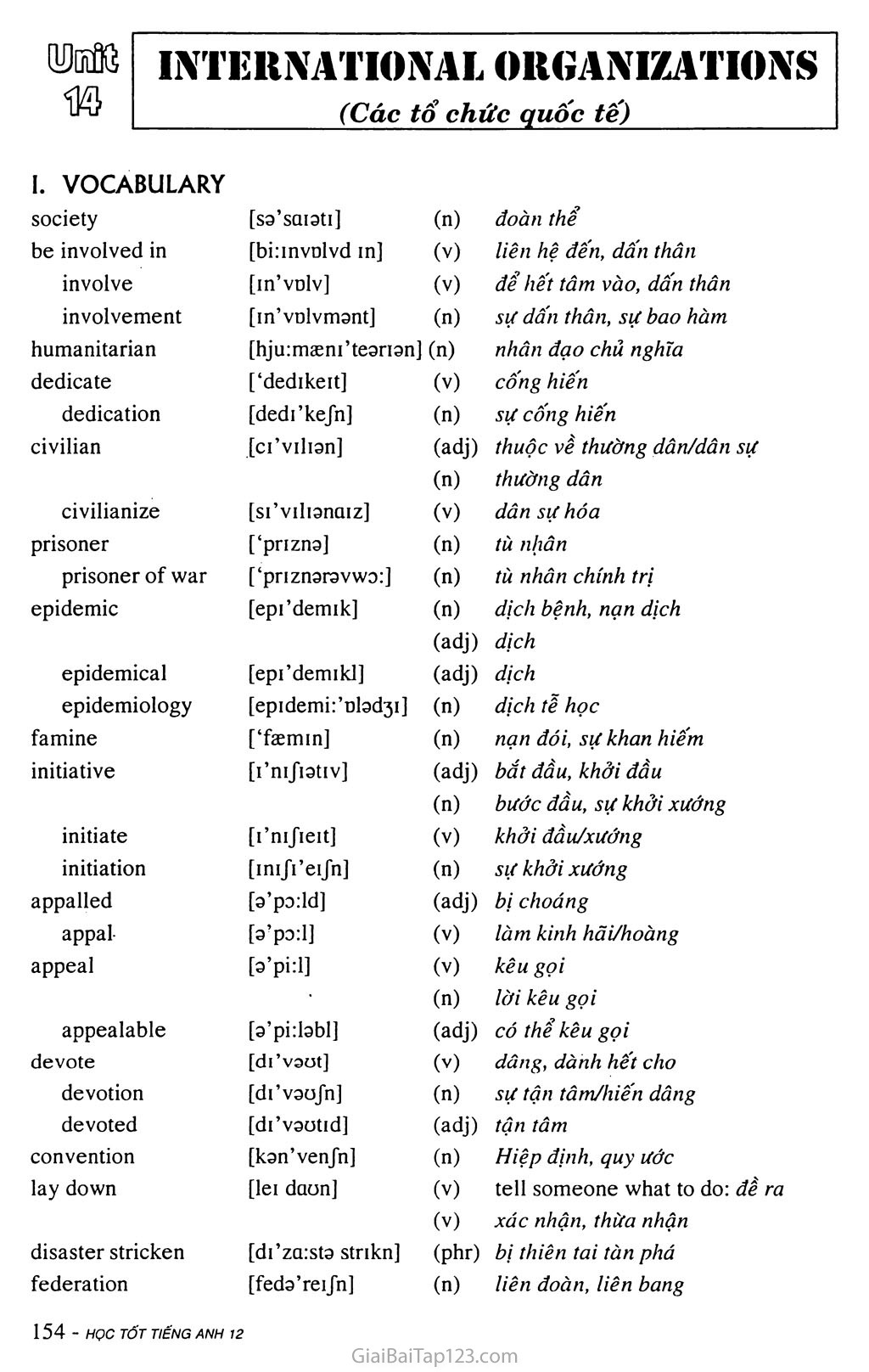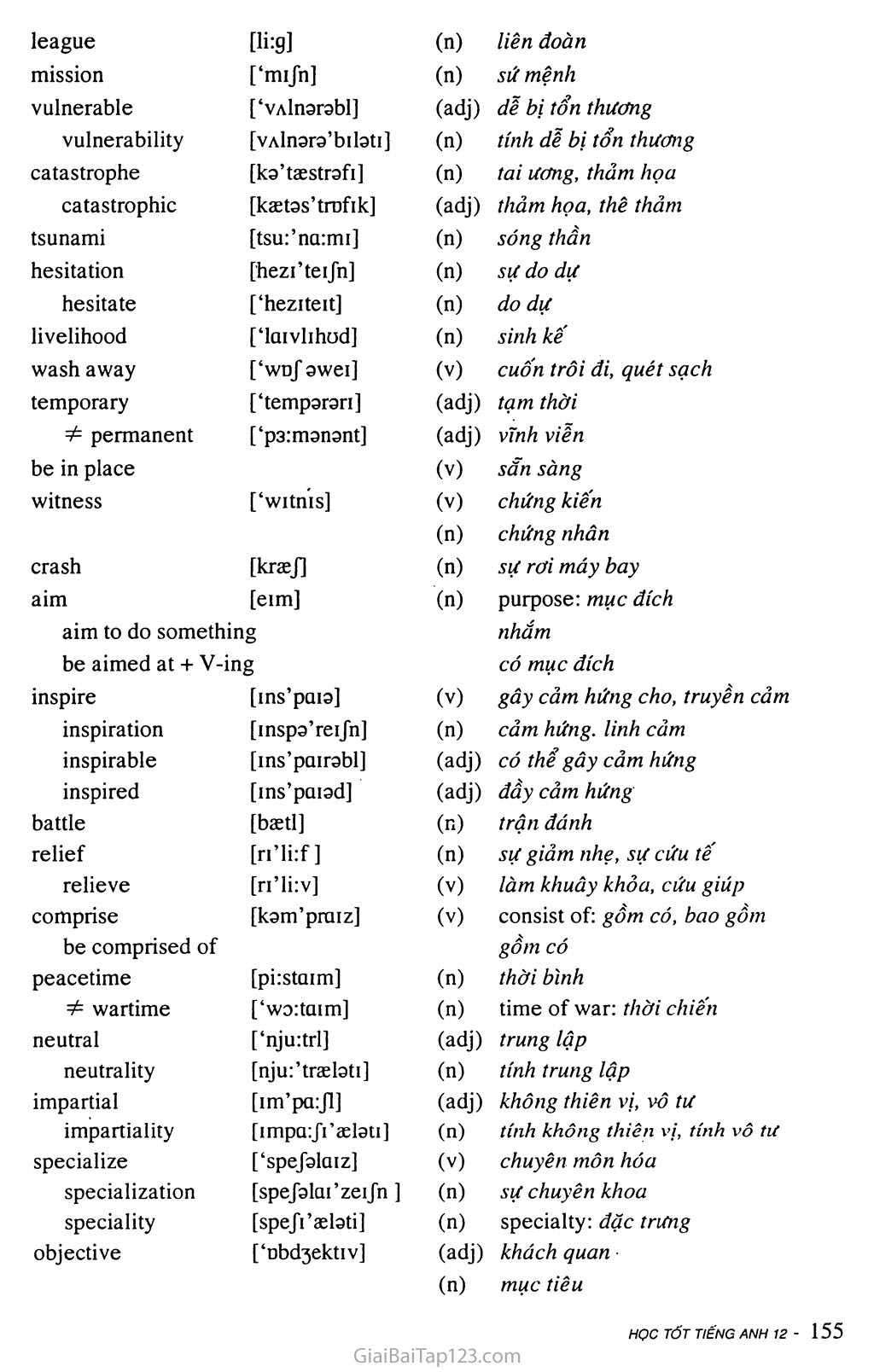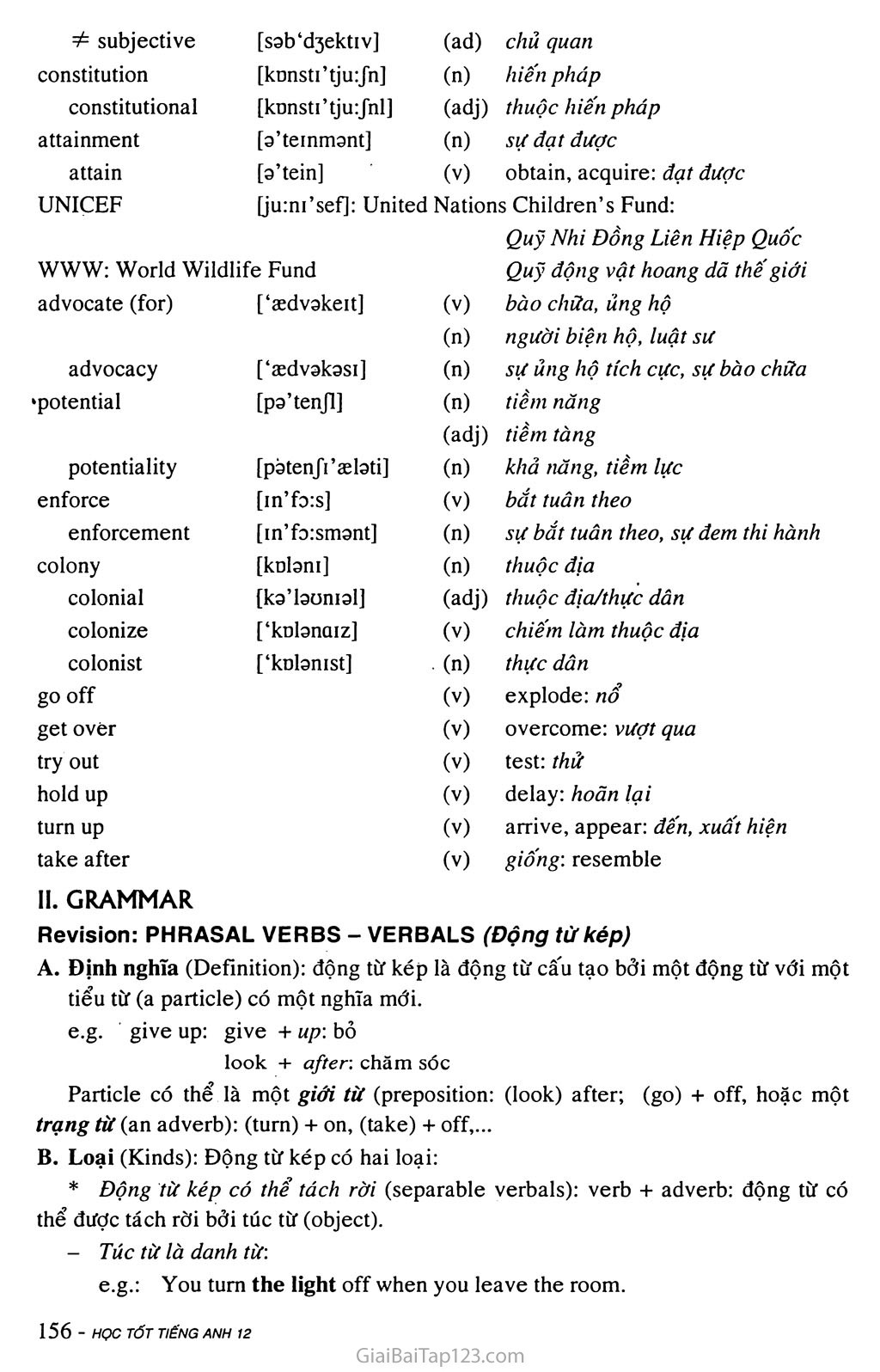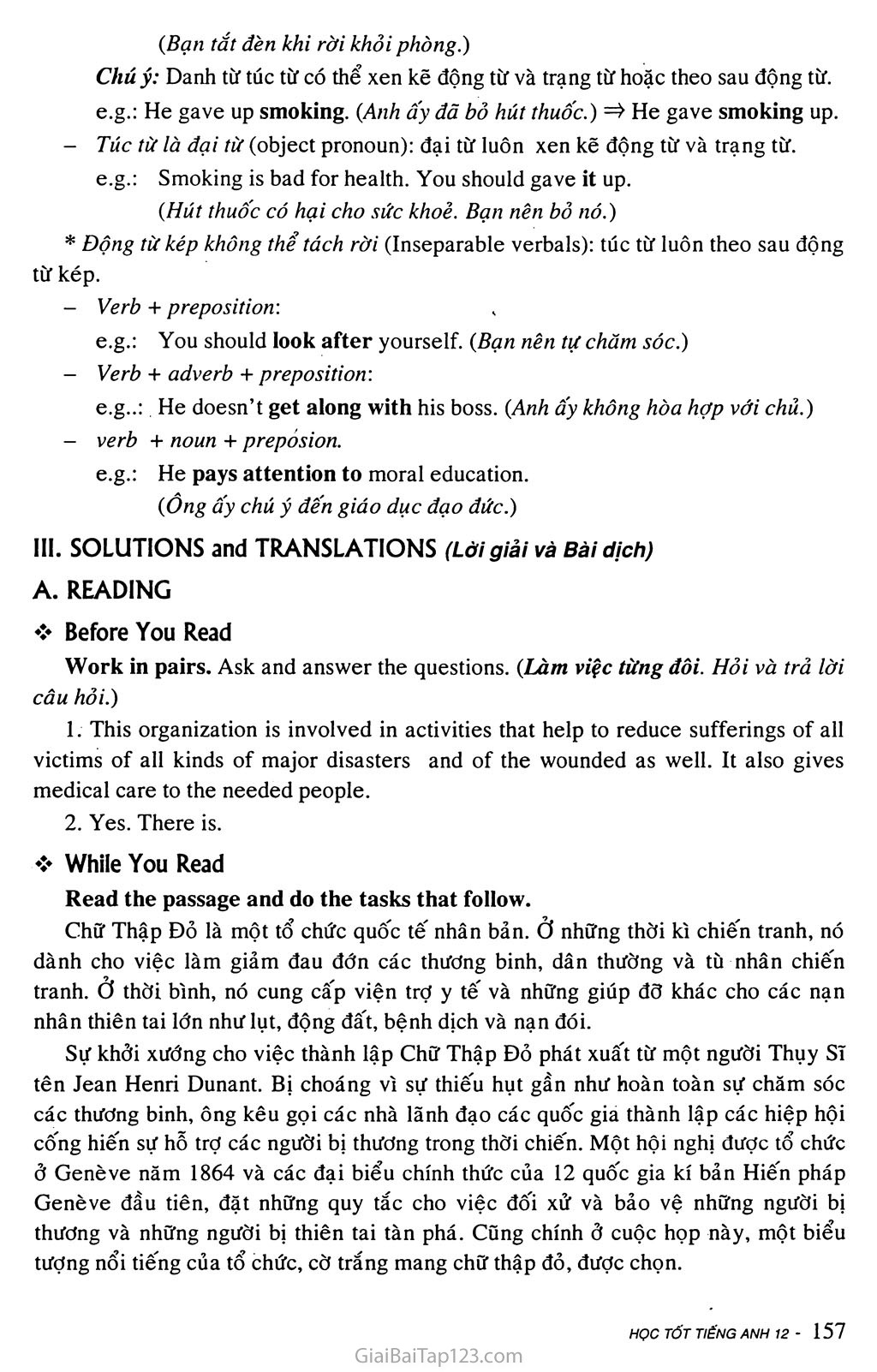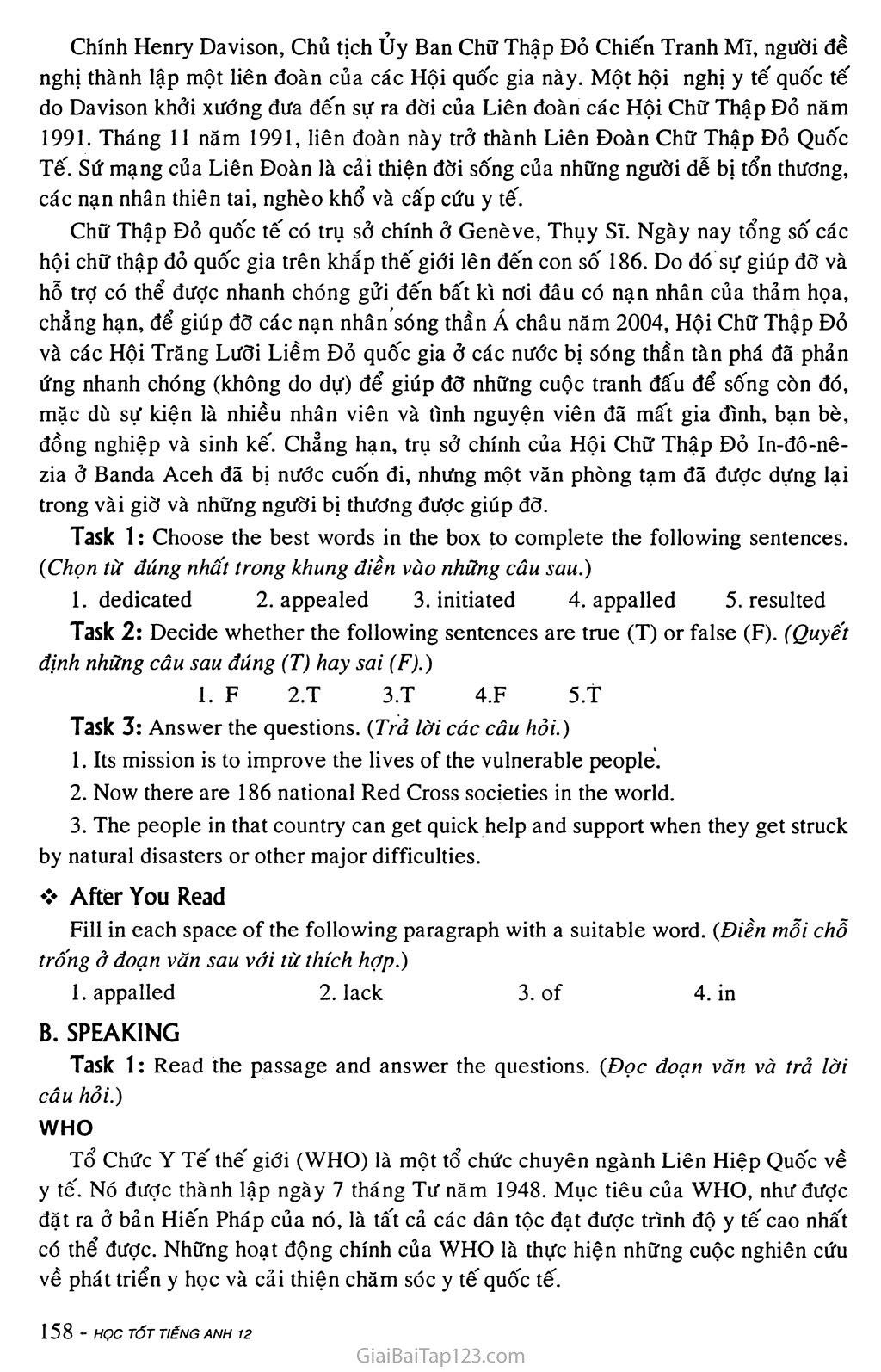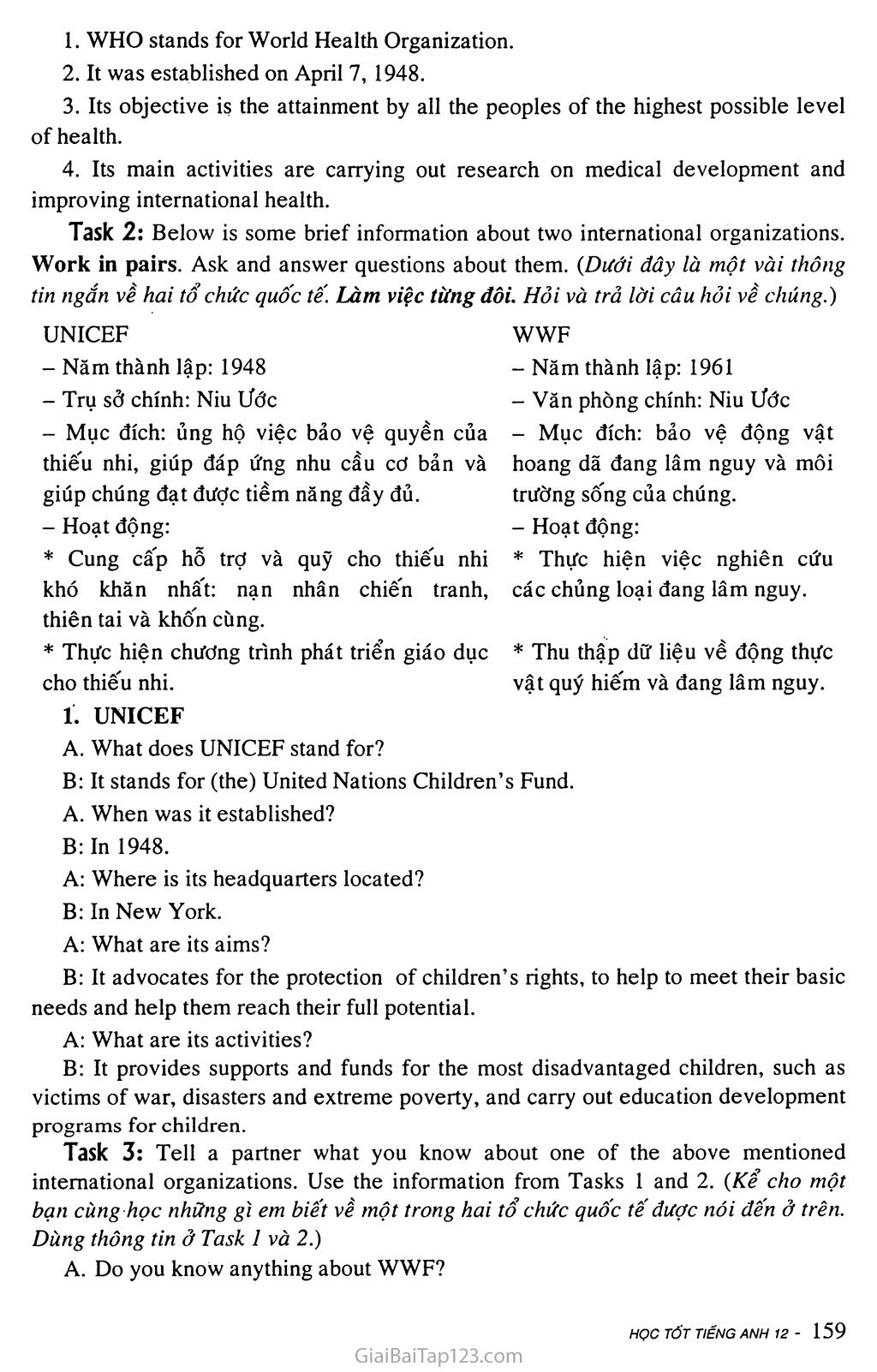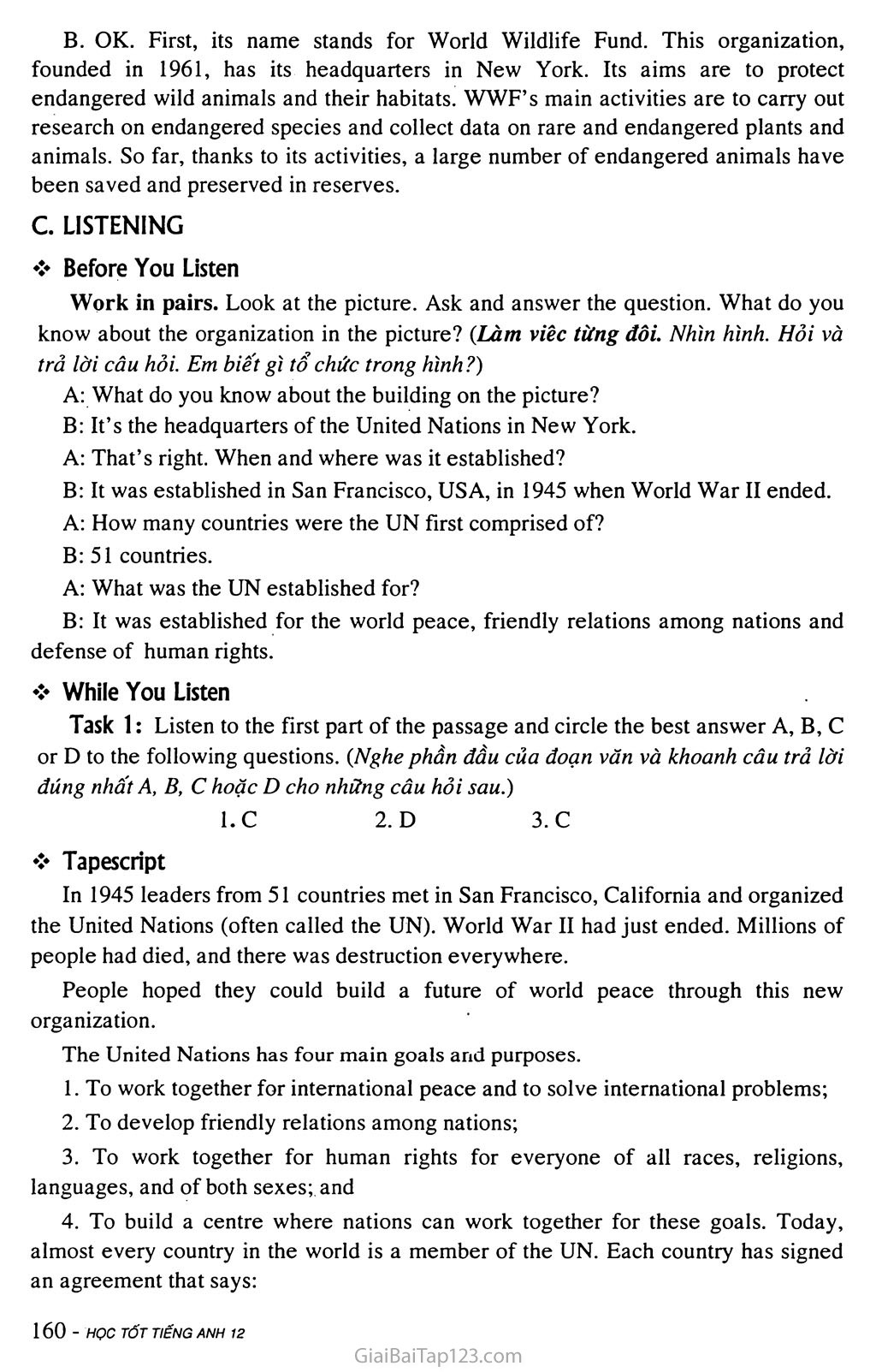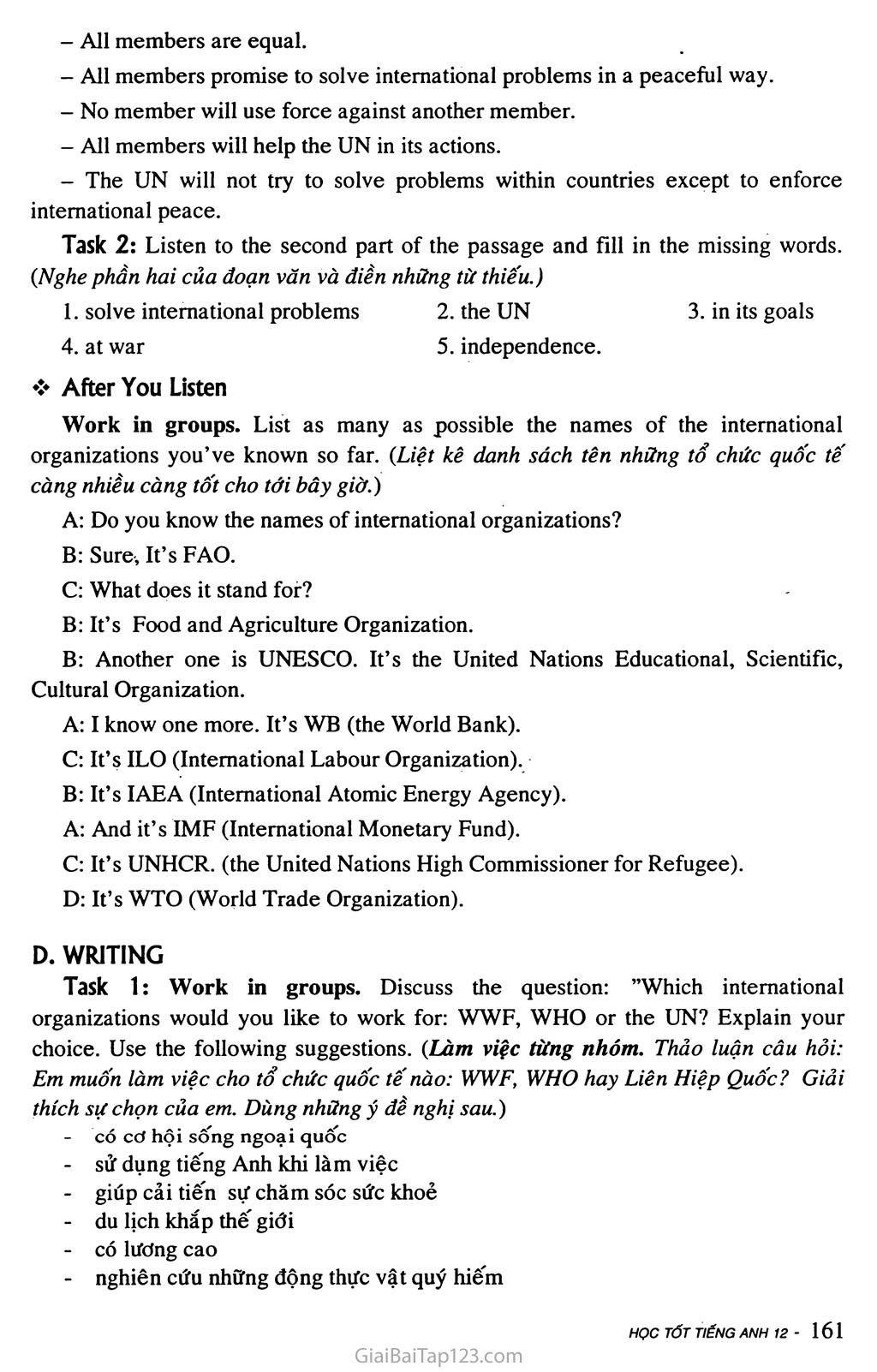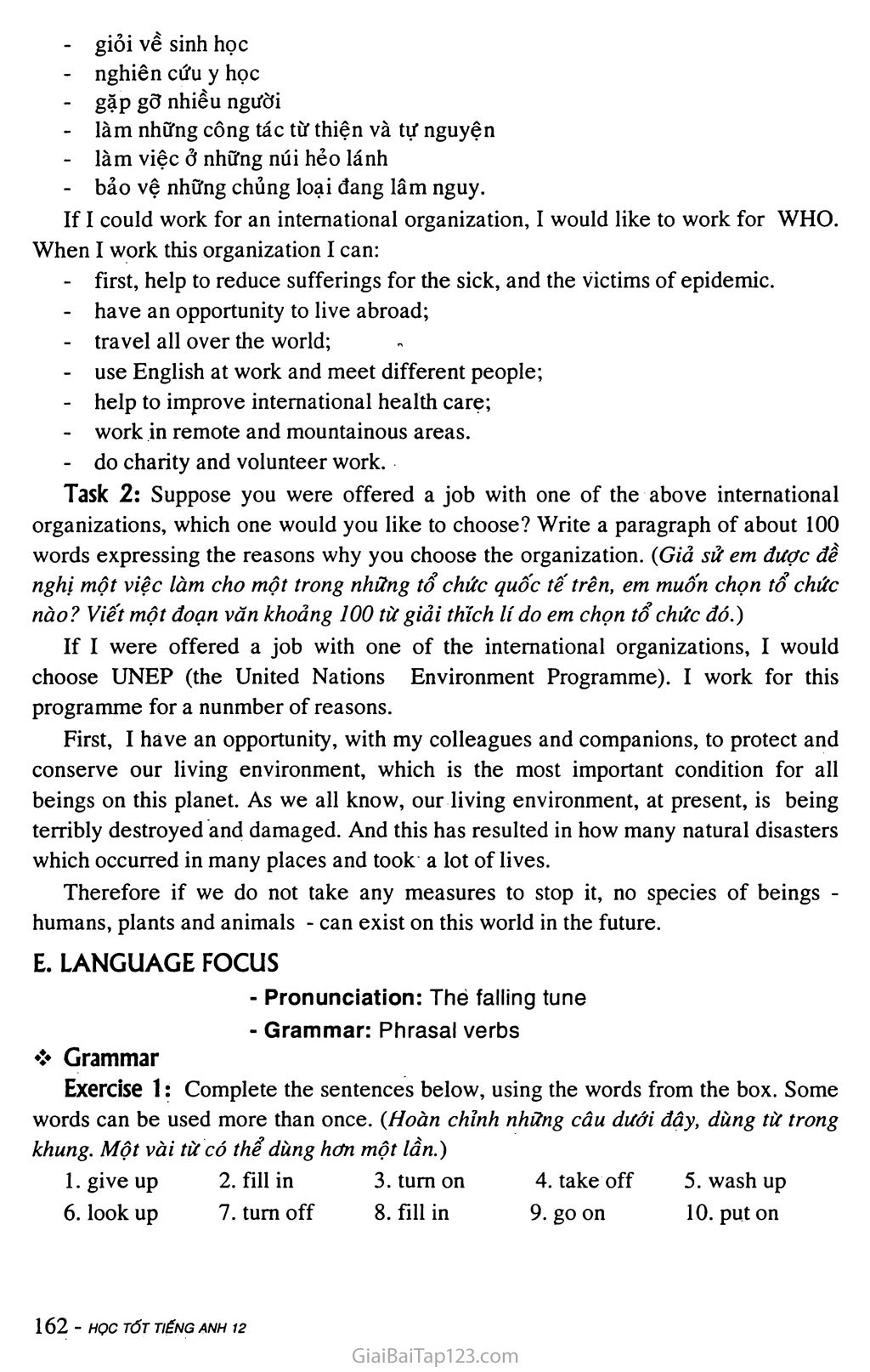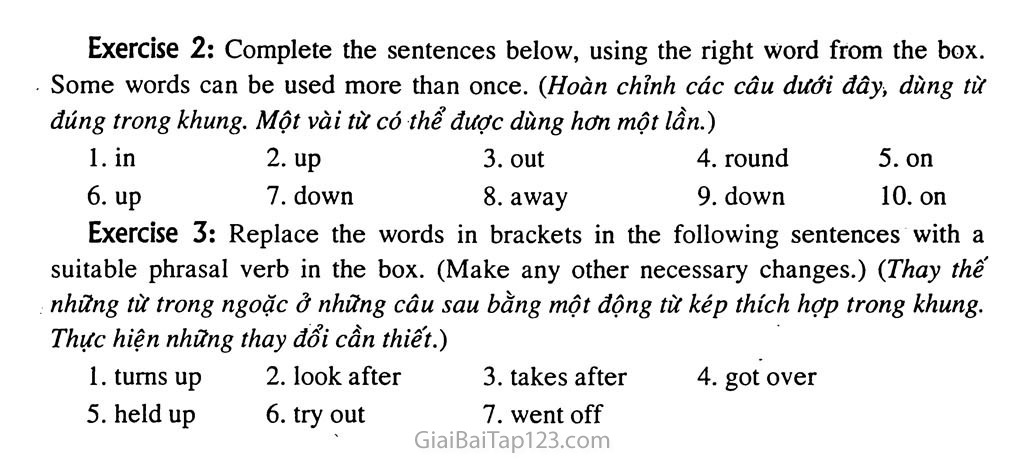Giải tiếng Anh lớp 12 Unit 14: INTERNATIONAL ORGANIZATIONS
INTERNATIONAL ORGANIZATIONS
(Các tổ chức quốc tế)
I. VOCABULARY
society
[sa’saiati]
(n)
đoàn thể
be involved in
[bkinvDlvd in]
(V)
liên hệ đến, dấn thân
involve
[in’vDlv]
(V)
để hết tâm vào, dấn thân
involvement
[in’vDlvmant]
(n)
sự dấn thân, sự bao hàm
humanitarian
[hjmmaEm’tearion] (n)
nhân đạo chủ nghĩa
dedicate
[‘dedikeit]
(V)
công hiến
dedication
[dedi’kejn]
(n)
sự cống hiến
civilian
[ci’vilian]
(adj)
(n)
thuộc về thường dân/dân sự thường dân
civilianize
[si’vilianaiz]
(V)
dân sự hóa
prisoner
[‘prizna]
(n)
tù nhân
prisoner of war
[‘priznaravwo:]
(n)
tù nhân chính trị
epidemic
[epi’demik]
(n)
(adj)
dịch bệnh, nạn dịch dịch
epidemical
[epi’demikl]
(adj)
dịch
epidemiology
[epidemidDladỊi]
(n)
dịch tễ học
famine
[‘fsemin]
(n)
nạn đói, sự khan hiếm
initiative
[I’mjiotiv]
(adj)
(n)
bắt đầu, khởi đầu bước đầu, sự khởi xướng
initiate
[I’mjieit]
(V)
khởi đầu/xướng
initiation
[iniji’eijn]
(n)
sự khởi xướng
appalled
[a’podd]
(adj)
bị choáng
appal
[a’pod]
(V)
làm kinh hãi/hoàng
appeal
[3’pi:l]
(V)
(n)
kêu gọi lời kêu gọi
appealable
[a’pidabl]
(adj)
có thể kêu gọi
devote
[di’vaot]
(V)
dâng, dành hết cho
devotion
[di’vaojn]
(n)
sự tận tâm/hiến dâng
devoted
[di’vaotid]
(adj)
tận tâm
convention
[kan’venfn]
(n)
Hiệp định, quy ước
lay down
[lei daon]
(V)
(V)
tell someone what to do: đề ra xác nhận, thừa nhận
disaster stricken
[di’za:st3 strikn]
(phr)
bị thiên tai tàn phá
federation
[feda’reijn]
(n)
liên đoàn, liên bang
league
[li:g]
(n)
liên đoàn
mission
[‘mijn]
(n)
sứ mệnh
vulnerable
[‘vAlnorabl]
(adj)
dễ bị tổn thương
vulnerability
[vAlnara’bibti]
(n)
tính dễ bị tổn thương
catastrophe
[ko’taestrsfi]
(n)
tai ương, thảm họa
catastrophic
[kffitos’trofik]
(adj)
thảm họa, thê thảm
tsunami
[tsu:’nu:mi]
(n)
sóng thần
hesitation
[hezi’teijn]
(n)
sự do dự
hesitate
[‘heziteit]
(n)
do dự
livelihood
[‘laivlihod]
(n)
sinh kế
wash away
[‘wpf owei]
(V)
cuốn trôi đi, quét sạch
temporary
[‘temporori]
(adj)
tạm thời
=# permanent
[‘p3:man3nt]
(adj)
vĩnh viễn
be in place
(V)
sẵn sàng
witness
[‘witnisj
(V)
(n)
chứng kiến chứng nhân
crash
[kraejl
(n)
sự rơi máy bay
aim
[eim]
(n)
purpose: mục đích
aim to do somethin
g
nhắm
be aimed at + V-ing
có mục đích
inspire
[ins’pum]
(V)
gây cảm hứng cho, truyền cảm
inspiration
[inspo’reijn]
(n)
cảm hứng, linh cảm
inspirable
[ins’pairabl]
(adj)
có thể gây cảm hứng
inspired
[ins’pamd]
(adj)
đầy cỏm hứng
battle
[bastl]
(it)
trận đánh
relief
[n’li:f ]
(n)
sự giảm nhẹ, sự cứu tế
relieve
[ri’li:v]
(V)
làm khuây khỏa, cứu giúp
comprise
be comprised of
[kom’praiz]
(V)
consist of: gồm có, bao gồm gồm có
peacetime
[pkstaim]
(n)
thời bình
=# wartime
[‘wo:taim]
(n)
time of war: thời chiến
neutral
f‘nju:trl]
(adj)
trung lập
neutrality
[nju:’trael3ti]
(n)
tính trung lập
impartial
[im’pmjl]
(adj)
không thiên vị, vô tư
impartiality
[impa:JYael3ti]
(it)
tính không thiên vị, tính vô tư
specialize
1‘spejblaiz]
(V)
chuyên môn hóa
specialization
[spejblai’zeijn ]
(n)
sự chuyên khoa
speciality
[speji’aelsti]
(n)
specialty: đặc trưng
objective
[‘DbdỊektiv]
(adj)
(n)
khách quan mục tiêu
=# subjective
[sob‘d3ektiv]
(ad)
chủ quan
constitution
[kDnsti’tju:Jn]
(n)
hiến pháp
constitutional
[kunsti’tju:Jhl]
(adj)
thuộc hiến pháp
attainment
[o’teinmont]
(n)
sự đạt được
attain
[o’tein]
(V)
obtain, acquire: đạt được
UNICEF 0u:ni’sef]: United Nations Children’s Fund:
Quỹ Nhi Đồng Liên Hiệp Quốc
WWW: World Wildlife Fund Quỹ động vật hoang dã thế giới
advocate (for)
[‘asdvokeit]
(V)
(n)
bào chữa, ủng hộ người biện hộ, luật sư
advocacy
[‘asdvakosi]
(n)
sự ủng hộ tích cực, sự bào chữa
■potential
[pa’tenJI]
(n)
tiềm năng
(adj)
tiềm tàng
potentiality
[pbtenffaslsti]
(n)
khả năng, tiềm lực
enforce
[in’fo:s]
(V)
bắt tuân theo
enforcement
tin’fo:sm3nt]
(n)
sự bắt tuân theo, sự đem thi hành
colony
[kDlom]
(n)
thuộc địa
colonial
[ko’loonial]
(adj)
thuộc địa/thực dân
colonize
[‘kDlonaiz]
(V)
chiếm lùm thuộc địa
colonist
[‘kDlomst]
(n)
thực dân
go off
(V)
explode: nổ
get over
(V)
overcome: vượt qua
try out
(V)
test: thử
hold up
(V)
delay: hoãn lại
turn up
(V)
arrive, appear: đến, xuất hiện
take after
(V)
giông: resemble
II. GRAMMAR
Revision: PHRASAL VERBS - VERBALS (Động từ kép)
Định nghĩa (Definition): động từ kép là động tù’ câu tạo bởi một động từ với một tiểu từ (a particle) có một nghĩa mới.
e.g. give up: give + up-, bỏ
look + after-, chăm sóc
Particle có thể là một giới từ (preposition: (look) after; (go) + off, hoặc một trạng tò (an adverb): (turn) + on, (take) + off,...
Loại (Kinds): Động từ kép có hai loại:
* Động từ kép có thể tách rời (separable verbals): verb + adverb: động từ có thể được tách rời bởi túc từ (object).
- Túc từ là danh từ:
e.g.: You turn the light off when you leave the room.
(Bạn tắt đèn khi rời khỏi phòng.)
Chú ý: Danh từ túc từ có thể xen kẽ động từ và trạng từ hoặc theo sau động từ. e.g.: He gave up smoking. (Anh ấy đã bỏ hút thuốc.) => He gave smoking up.
Túc từ là đại từ (object pronoun): đại từ luôn xen kẽ động từ và trạng từ. e.g.: Smoking is bad for health. You should gave it up.
(Hút thuốc có hại cho sức khoẻ. Bạn nên bỏ nó.)
* Động từ kép không thể tách rời (Inseparable verbals): túc từ luôn theo sau động từ kép.
Verb + preposition:
e.g.: You should look after yourself. (Bạn nên tự chăm sóc.)
Verb + adverb + preposition:
e.g..: He doesn’t get along with his boss. (Anh ấy không hòa hợp với chủ.)
verb + noun + prepósion.
e.g.: He pays attention to moral education.
(Ong ấy chú ý đến giáo dục đạo đức.)
III. SOLUTIONS and TRANSLATIONS (Lời giải và Bài dịch)
A. READING
Before You Read
Work in pairs. Ask and answer the questions. (Làm việc từng đôi. Hỏi và trả lời câu hỏi.)
This organization is involved in activities that help to reduce sufferings of all victims of all kinds of major disasters and of the wounded as well. It also gives medical care to the needed people.
Yes. There is.
While You Read
Read the passage and do the tasks that follow.
Chữ Thập Đỏ là một tổ chức quốc tế nhân bản. Ở những thời kì chiến tranh, nó dành cho việc làm giảm đau đớn các thương binh, dân thường và tù nhân chiến tranh. Ở thời bình, nó cung cấp viện trỢ y tế và những giúp đỡ khác cho các nạn nhân thiên tai lớn như lụt, động đất, bệnh dịch và nạn đói.
Sự khởi xướng cho việc thành lập Chữ Thập Đỏ phát xuất từ một người Thụy Sĩ tên Jean Henri Dunant. Bị choáng vì sự thiếu hụt gần như hoàn toàn sự chăm sóc các thương binh, ông kêu gọi các nhà lãnh đạo các quốc gia thành lập các hiệp hội cống hiến sự hỗ trợ các người bị thương trong thời chiến. Một hội nghị được tổ chức ở Genève nãm 1864 và các đại biểu chính thức của 12 quốc gia kí bản Hiên pháp Genève đầu tiên, đặt những quy tắc cho việc đốì xử và bảo vệ những người bị thương và những người bị thiên tai tàn phá. Cũng chính ở cuộc họp này, một biểu tượng nổi tiếng của tổ chức, cờ trắng mang chữ thập đỏ, được chọn.
Chính Henry Davison, Chủ tịch ủy Ban Chữ Thập Đỏ Chiến Tranh Mĩ, người đề nghị thành lập một liên đoàn của các Hội quốc gia này. Một hội nghị y tế quốc tế do Davison khởi xướng đưa đến sự ra đời của Liên đoàn các Hội Chữ Thập Đỏ năm 1991. Tháng 11 năm 1991, liên đoàn này trở thành Liên Đoàn Chữ Thập Đỏ Quốc Tế. Sứ mạng của Liên Đoàn là cải thiện đời sống của những người dễ bị tổn thương, các nạn nhân thiên tai, nghèo khổ và cấp cứu y tế.
Chữ Thập Đỏ quốc tế có trụ sở chính ở Genève, Thụy Sĩ. Ngày nay tổng số các hội chữ thập đỏ quốc gia trên khắp thế giới lên đến con sô" 186. Do đó sự giúp đỡ và hỗ trợ có thể được nhanh chóng gửi đến bất kì nơi đâu có nạn nhân của thảm họa, chẳng hạn, để giúp đỡ các nạn nhân sóng thần Á châu năm 2004, Hội Chữ Thập Đỏ và các Hội Trăng Lưỡi Liềm Đỏ quôc gia ở các nước bị sóng thần tàn phá đã phản ứng nhanh chóng (không do dự) để giúp đỡ những cuộc tranh đấu để sông còn đó, mặc dù sự kiện là nhiều nhân viên và tình nguyện viên đã mất gia đình, bạn bè, đồng nghiệp và sinh kế. Chẳng hạn, trụ sở chính của Hội Chữ Thập Đỏ In-đô-nê- zia ở Banda Aceh đã bị nước cuốn đi, nhưng một văn phòng tạm đã được dựng lại trong vài giờ và những người bị thương được giúp đỡ.
Task 1: Choose the best words in the box to complete the following sentences. (Chọn từ đúng nhất trong khung điền vào những câu sau.)
dedicated 2. appealed 3. initiated 4. appalled 5. resulted
Task 2: Decide whether the following sentences are true (T) or false (F). (Quyết định những câu sau đúng (T) hay sai (F).)
F 2.T 3.T 4.F 5.T
Task 3: Answer the questions. (Trả lời các câu hỏi.)
Its mission is to improve the lives of the vulnerable people.
Now there are 186 national Red Cross societies in the world.
The people in that country can get quick help and support when they get struck by natural disasters or other major difficulties.
❖ After You Read
Fill in each space of the following paragraph with a suitable word. (Điền mỗi chỗ trống ở đoạn văn sau với từ thích hợp.)
1. appalled 2. lack 3. of 4. in
B, SPEAKING
Task 1: Read the passage and answer the questions. (Đọc đoạn văn và trả lời câu hỏi.)
WHO
Tổ Chức Y Tế thế giới (WHO) là một tổ chức chuyên ngành Liên Hiệp Quôc về y tế. Nó được thành lập ngày 7 tháng Tư năm 1948. Mục tiêu của WHO, như được đặt ra ở bản Hiến Pháp của nó, là tất cả các dân tộc đạt được trình độ y tế cao nhát có thể được. Những hoạt động chính của WHO là thực hiện những cuộc nghiên cứu về phát triển y học và cải thiện chăm sóc y tế quốc tế.
WHO stands for World Health Organization.
It was established on April 7, 1948.
Its objective is the attainment by all the peoples of the highest possible level of health.
Its main activities are carrying out research on medical development and improving international health.
Task 2: Below is some brief information about two international organizations. Work in pairs. Ask and answer questions about them. {Dưới đây là một vài thông tin ngắn về hai tổ chức quốc tế. Làm việc từng đôi. Hỏi và trả lời câu hỏi về chúng.) UNICEF WWF
Năm thành lập: 1961
Văn phòng chính: Niu Ước
Mục đích: bảo vệ động vật hoang dã đang lâm nguy và môi trường sống của chúng.
Hoạt động:
Thực hiện việc nghiên cứu các chủng loại đang lâm nguy.
Thu thập dữ liệu về động thực vật quý hiếm và đang lâm nguy.
Năm thành lập: 1948
Trụ sở chính: Niu ước
Mục đích: ủng hộ việc bảo vệ quyền của thiếu nhi, giúp đáp ứng nhu cầu cơ bản và giúp chúng đạt được tiềm năng đầy đủ.
Hoạt động:
Cung câp hỗ trợ và quỹ cho thiếu nhi khó khăn nhát: nạn nhân chiến tranh, thiên tai và khôn cùng.
Thực hiện chương trình phát triển giáo dục cho thiếu nhi.
í. UNICEF
A. What does UNICEF stand for?
B: It stands for (the) United Nations Children’s Fund.
A. When was it established?
B: In 1948.
A: Where is its headquarters located?
B: In New York.
A: What are its aims?
B: It advocates for the protection of children’s rights, to help to meet their basic needs and help them reach their full potential.
A: What are its activities?
B: It provides supports and funds for the most disadvantaged children, such as victims of war, disasters and extreme poverty, and carry out education development programs for children.
Task 3: Tell a partner what you know about one of the above mentioned international organizations. Use the information from Tasks 1 and 2. {Kể cho một bạn cùng học những gì em biết về một trong hai tổ chức quốc tế được nói đến ở trên. Dùng thông tin ở Task 1 và 2.)
A. Do you know anything about WWF?
B. OK. First, its name stands for World Wildlife Fund. This organization, founded in 1961, has its headquarters in New York. Its aims are to protect endangered wild animals and their habitats. WWF’s main activities are to carry out research on endangered species and collect data on rare and endangered plants and animals. So far, thanks to its activities, a large number of endangered animals have been saved and preserved in reserves.
c. LISTENING
Before You Listen
Work in pairs. Look at the picture. Ask and answer the question. What do you know about the organization in the picture? {Làm viêc từng đôi. Nhìn hình. Hỏi và trả lời câu hỏi. Em biết gì tổ chức trong hình?)
A: What do you know about the building on the picture?
B: It’s the headquarters of the United Nations in New York.
A: That’s right. When and where was it established?
B: It was established in San Francisco, USA, in 1945 when World War II ended.
A: How many countries were the UN first comprised of?
B: 51 countries.
A: What was the UN established for?
B: It was established for the world peace, friendly relations among nations and defense of human rights.
While You Listen
Task 1: Listen to the first part of the passage and circle the best answer A, B, c or D to the following questions. {Nghe phần đầu của đoạn văn và khoanh câu trả lởi đúng nhất A, B, c hoặc D cho những câu hỏi sau.)
l.c 2. D 3. c
Tapescript
In 1945 leaders from 51 countries met in San Francisco, California and organized the United Nations (often called the UN). World War II had just ended. Millions of people had died, and there was destruction everywhere.
People hoped they could build a future of world peace through this new organization.
The United Nations has four main goals and purposes.
To work together for international peace and to solve international problems;
To develop friendly relations among nations;
To work together for human rights for everyone of all races, religions, languages, and of both sexes; and
To build a centre where nations can work together for these goals. Today, almost every country in the world is a member of the UN. Each country has signed an agreement that says:
All members are equal.
All members promise to solve international problems in a peaceful way.
No member will use force against another member.
All members will help the UN in its actions.
The UN will not try to solve problems within countries except to enforce international peace.
Task 2: Listen to the second part of the passage and fill in the missing words. (Nghe phần hai của đoạn văn và điền những từ thiếu.)
solve international problems 2. the UN 3. in its goals
at war 5. independence.
❖ After You Listen
Work in groups. List as many as possible the names of the international organizations you’ve known so far. (Liệt kê danh sách tên những tổ chức quốc tế càng nhiều càng tốt cho tới bây giờ.)
A: Do you know the names of international organizations?
B: Sure, It’s FAO.
C: What does it stand for?
B: It’s Food and Agriculture Organization.
B: Another one is UNESCO. It’s the United Nations Educational, Scientific, Cultural Organization.
A: I know one more. It’s WB (the World Bank).
C: It’s ILO (International Labour Organization).
B: It’s IAEA (International Atomic Energy Agency).
A: And it’s IMF (International Monetary Fund).
C: It’s UNHCR, (the United Nations High Commissioner for Refugee).
D: It’s WTO (World Trade Organization).
D. WRITING
Task 1: Work in groups. Discuss the question: ’’Which international organizations would you like to work for: WWF, WHO or the UN? Explain your choice. Use the following suggestions. (Làm việc từng nhóm. Thảo luận câu hỏi: Em muốn làm việc cho tổ chức quốc tế nào: WWF, WHO hay Liên Hiệp Quốc? Giải thích sự chọn của em. Dùng những ý đề nghị sau.)
có cơ hội sông ngoại quốc
sử dụng tiếng Anh khi làm việc
giúp cải tiến sự chăm sóc sức khoẻ
du lịch khắp thế giới
có lương cao
nghiên cứu những động thực vật quý hiếm
giỏi về sinh học
nghiên cứu y học
gặp gỡ nhiều người
làm những công tác từ thiện và tự nguyện
làm việc ở những núi hẻo lánh
bảo vệ những chủng loại đang lâm nguy.
If I could work for an international organization, I would like to work for WHO. When I work this organization I can:
first, help to reduce sufferings for the sick, and the victims of epidemic.
have an opportunity to live abroad;
travel all over the world;
use English at work and meet different people;
help to improve international health care;
work in remote and mountainous areas.
do charity and volunteer work.
Task 2: Suppose you were offered a job with one of the above international organizations, which one would you like to choose? Write a paragraph of about 100 words expressing the reasons why you choose the organization. (Giả sử em được đề nghị một việc làm cho một trong những tổ chức quốc tê' trên, em muốn chọn tổ chức nào? Viết một đoạn văn khoảng 100 từ giải thích lí do em chọn tổ chức đó.)
If I were offered a job with one of the international organizations, I would choose UNEP (the United Nations Environment Programme). I work for this programme for a nunmber of reasons.
First, I have an opportunity, with my colleagues and companions, to protect and conserve our living environment, which is the most important condition for all beings on this planet. As we all know, our living environment, at present, is being terribly destroyed and damaged. And this has resulted in how many natural disasters which occurred in many places and took a lot of lives.
Therefore if we do not take any measures to stop it, no species of beings - humans, plants and animals - can exist on this world in the future.
E. LANGUAGE FOCUS
Pronunciation: The falling tune
Grammar: Phrasal verbs
❖ Grammar
Exercise 1: Complete the sentences below, using the words from the box. Some words can be used more than once. (Hoàn chỉnh những câu dưới đây, dùng từ trong khung. Một vài từ có thể dùng hơn một lần.)
give up 2. fill in 3. turn on 4. take off 5. wash up
look up 7. turn off 8. fill in 9. go on 10. put on
Exercise 2: Complete the sentences below, using the right word from the box. Some words can be used more than once. {Hoàn chỉnh các câu dưới đây, dùng từ đúng trong khung. Một vài từ có thể được dùng hơn một lần.)
in 2. up 3. out 4. round 5. on
up 7. down 8. away 9. down 10. on
Exercise 3: Replace the words in brackets in the following sentences with a suitable phrasal verb in the box. (Make any other necessary changes.) (Thay the những từ trong ngoặc ở những câu sau bằng một động từ kép thích hợp trong khung. Thực hiện những thay đổi cần thiết.)
1. turns up 2. look after 3. takes after 4. got over
held up 6. try out 7. went off

